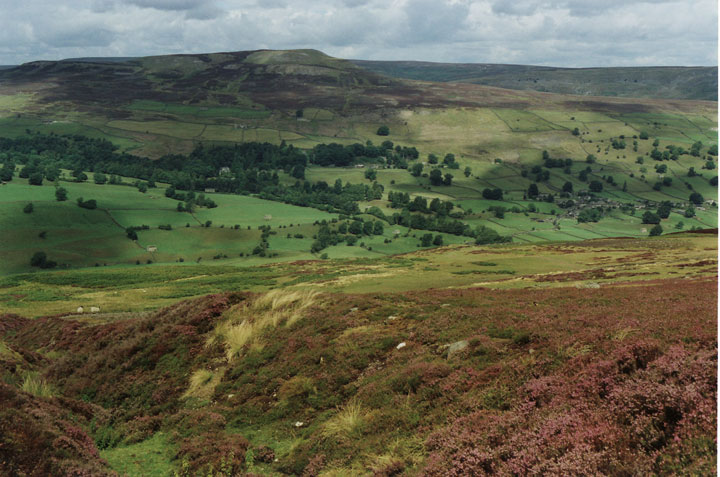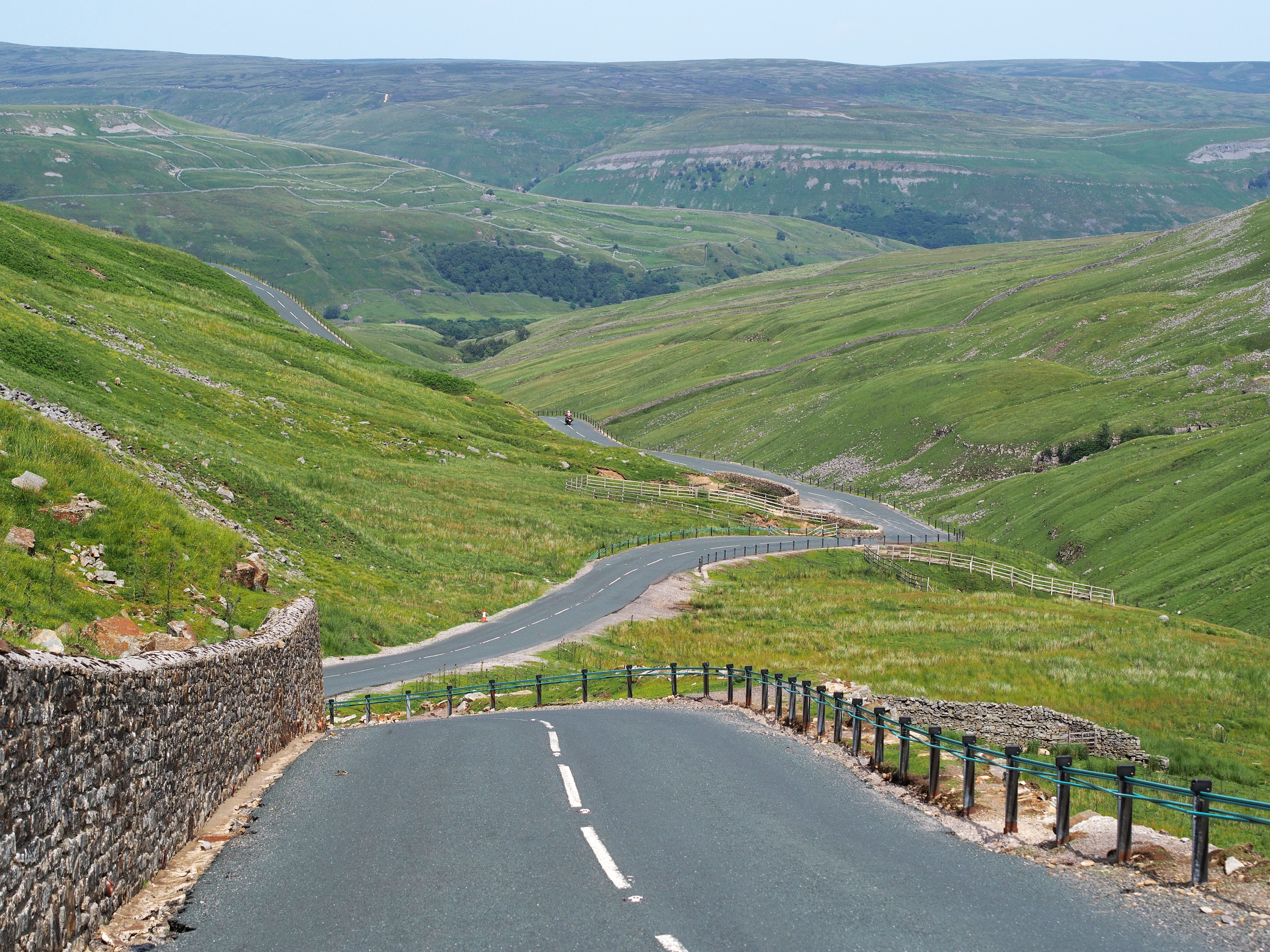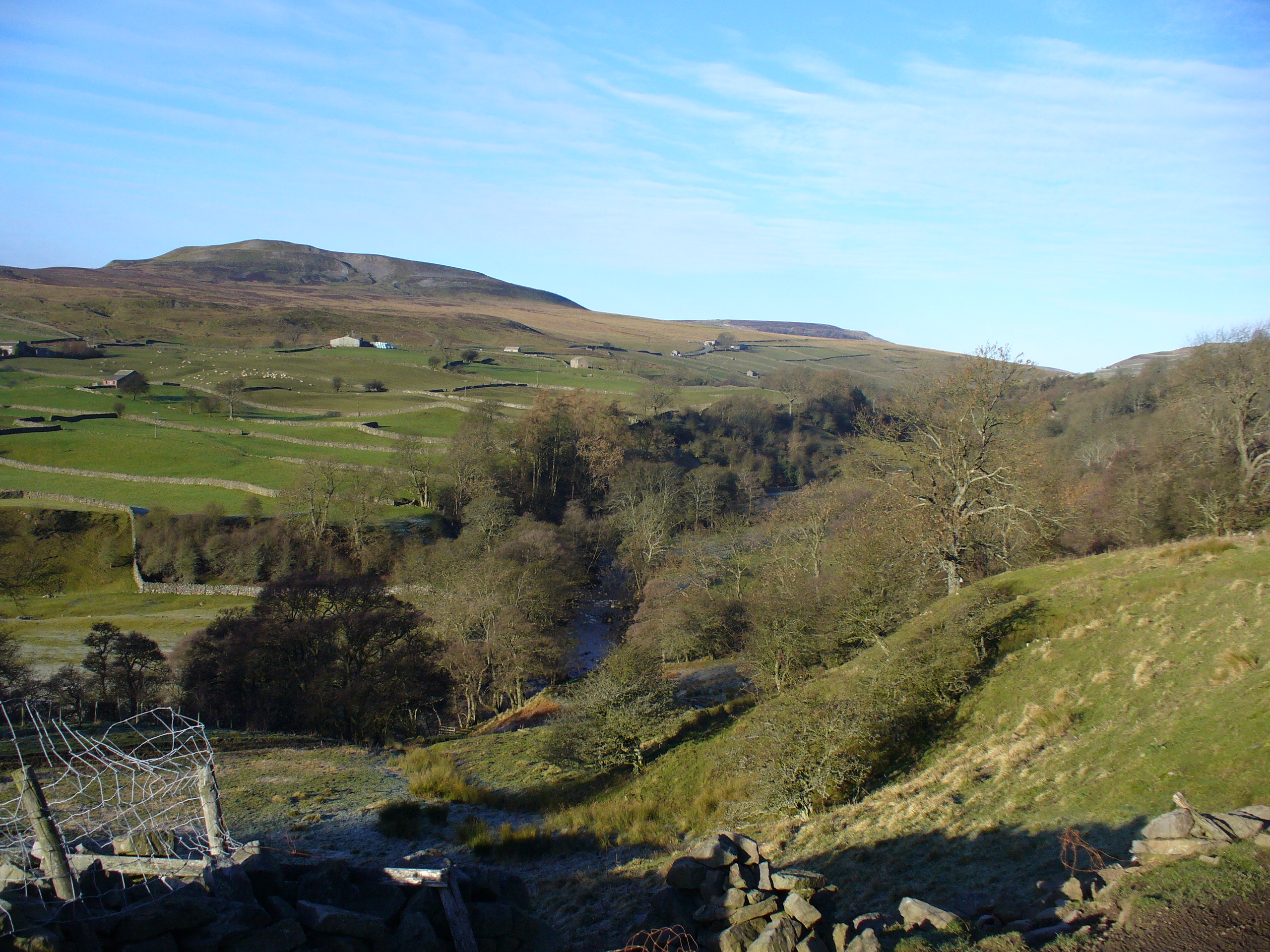|
Swaledale, North Yorkshire
Swaledale is one of the northernmost dales ( valleys) in Yorkshire Dales National Park, located in northern England. It is the dale of the River Swale on the east side of the Pennines in North Yorkshire. Geographical overview Swaledale runs broadly from west to east, from the high moors on the Cumbria–Yorkshire boundary at the watershed of Northern England to the market town of Richmond, where the dale meets the lowlands. Nine Standards Rigg, the prominent ridge with nine ancient tall cairns, rises on the watershed at the head of Swaledale. To the south and east of the ridge a number of smaller dales ( Birkdale, Little Sleddale, Great Sleddale and Whitsundale) join to form the narrow valley of upper Swaledale at the small village of Keld. From there, the valley runs briefly south then turns east at Thwaite to broaden progressively as it passes Muker, Gunnerside, Low Row, Healaugh and Reeth. The Pennine valley ends at Richmond, where an important medieval ... [...More Info...] [...Related Items...] OR: [Wikipedia] [Google] [Baidu] |
Gunnerside
Gunnerside is a village in the Richmondshire district of North Yorkshire, England. It is situated on the B6270 road, east of Muker and west of Grinton. The village lies between the River Swale and its tributary, Gunnerside Beck, in the Swaledale part of the Yorkshire Dales National Park. History The name of the village derives from an Old Norse personal name ''Gunnar'' and ''sætr'' meaning hill or pasture. Gunnerside Ghyll (or Gunnerside Gill), a smaller valley running northwards, at right angles to the Swale valley (Swaledale), was the site of a major lead mining industry in Swaledale until the late nineteenth century. The beck that runs through the narrow valley, also called Gunnerside Gill, or Gunnerside Beck, rises between Rogan's Seat and Water Crag, and runs for emptying into the River Swale at the site of Gunnerside New Bridge. The bridge carries the B6270 over the River Swale south of the village; it was rebuilt several times during the 19th century due to floodi ... [...More Info...] [...Related Items...] OR: [Wikipedia] [Google] [Baidu] |
Buttertubs Pass
The Buttertubs Pass is a high road in the Yorkshire Dales, England. The road winds its way north from Simonstone near Hawes towards Thwaite and Muker past limestone potholes called the Buttertubs. It is said that the name of the potholes came from the times when farmers would rest there on their way to market. During hot weather they would lower the butter they had produced into the potholes to keep it cool. The road is locally noted as a challenging cycle climb and featured as the second, and highest of three categorized climbs in Stage One of the 2014 Tour de France. The race was led over the climb by German veteran Jens Voigt, on his way to becoming the 2014 race's first wearer of the polka dot jersey as leader of the mountains classification. The climb was to be featured during the Men's elite road race of the 2019 UCI Road World Championships, but the race had to be rerouted due to heavy rain. Jeremy Clarkson featured the road in the "Motoring and the New Romantics" epi ... [...More Info...] [...Related Items...] OR: [Wikipedia] [Google] [Baidu] |
Great Shunner Fell
Great Shunner Fell is the third highest mountain in the Yorkshire Dales, North Yorkshire, England, and the highest point in Wensleydale; at 716 metres above sea level. In clear weather the summit affords views of Wensleydale to the south, Ribblesdale to the south west and Swaledale to the north, as well as views into Cumbria and County Durham beyond the A66. The Pennine Way passes over its summit, on the way from Hawes to Keld. The popularity of this route had eroded vegetation from a strip 70 m wide across the moor, which has been alleviated since 1996 by the construction of a path made of flagstones. The summit holds a cross-shaped windbreak of which the triangulation pillar has been built into the northern 'arm'. Great Sleddale Beck, which becomes the River Swale after its confluence with Birkdale Beck has its sources on the northern slopes of Great Shunner Fell, while the southern slopes drain into the River Ure and Wensleydale. The dominating ro ... [...More Info...] [...Related Items...] OR: [Wikipedia] [Google] [Baidu] |
Wensleydale Cheese
Wensleydale is a style of cheese originally produced in Wensleydale, North Yorkshire, England, but now mostly made in large commercial creameries throughout the United Kingdom. The term "Yorkshire Wensleydale" can only be used for cheese that is made in Wensleydale. Flavour and texture Wensleydale is a medium cheese that is supple and crumbly. It has a slight honey aroma. Common flavour combinations The flavour of Wensleydale is suited to combination with sweeter produce, such as fruit like sweet apples. A popular combination available in many restaurants and delicatessens is cranberry Wensleydale, which contains cranberries in the cheese. In Yorkshire and North East England it is often eaten with fruit cake or Christmas cake. History Wensleydale cheese was first made by French Cistercian monks from the Roquefort region, who had settled in Wensleydale. They built a monastery at Fors, but some years later the monks moved to Jervaulx in Lower Wensleydale. They brought w ... [...More Info...] [...Related Items...] OR: [Wikipedia] [Google] [Baidu] |
Wensleydale
Wensleydale is the dale or upper valley of the River Ure on the east side of the Pennines, one of the Yorkshire Dales in North Yorkshire, England. It is one of only a few Yorkshire Dales not currently named after its principal river, but the older name, Yoredale, can still be seen on some maps and as the Yoredale Series of geological strata. The dale takes its name from the village of Wensley, once its market town. The valley is famous for its cheese, with the main commercial production at Hawes. Also famous are its ales from Theakston Brewery and Black Sheep Brewery in Masham. Most of the dale is within the Yorkshire Dales National Park. Part of lower Wensleydale, below East Witton, is within the Nidderdale Area of Outstanding Natural Beauty. Addlebrough, a fell, dominates the landscape of the upper dale, and Penhill at is prominent in the lower dale. History Wensleydale was the home of one of Yorkshire's most famous clans, the Metcalfes, after they emigrated from ... [...More Info...] [...Related Items...] OR: [Wikipedia] [Google] [Baidu] |
Arkle Beck
Arkle Beck is the stream running through the valley of Arkengarthdale in the Yorkshire Dales, England. It is a tributary of the River Swale, which it joins just past Reeth at Grinton Bridge. The beck itself has several tributaries which include: *Great Punchard Gill *William's Gill *Annaside Beck *Roe Beck In 1986, a section of the meadow alongside Arkle Beck at Whaw Whaw is a hamlet in Arkengarthdale in North Yorkshire, England. It is one of few settlements in the dale and is one of the smallest. Its name derives from the Old Norse of ''Kvi'' and ''Hagi'', which means the enclosure of the sheep. It is abou ... was designated as a site of special scientific interest (SSSI). References Rivers of North Yorkshire Arkengarthdale {{England-river-stub ... [...More Info...] [...Related Items...] OR: [Wikipedia] [Google] [Baidu] |
Arkengarthdale
Arkengarthdale is a dale, or valley, on the east side of the Pennines in North Yorkshire, England. Running roughly north-west to south-east, it is the valley of the Arkle Beck, and is the northernmost of the Yorkshire Dales. It is a subsidiary dale to Swaledale, which it joins at Reeth. The history of the dale, its people, and farming, lead mining, and local crafts is displayed and documented in the Swaledale Museum in Reeth. On its way up the dale from Reeth the unclassified road crosses many other small streams and their catchments, such as Great Punchard Gill, Roe Beck, Annaside Beck, and William Gill. It passes through several small settlements: Raw, Arkle Town, Langthwaite (where a narrow back road leads to Booze), Eskeleth and Whaw. At Eskeleth Bridge another unclassified road forks north-east (towards Barnard Castle); this also joins a minor road running along the northern side of the dale to Whaw. Beyond Whaw is the most sparsely populated upper part of Arkengarthda ... [...More Info...] [...Related Items...] OR: [Wikipedia] [Google] [Baidu] |
Humber
The Humber is a large tidal estuary on the east coast of Northern England. It is formed at Trent Falls, Faxfleet, by the confluence of the tidal rivers Ouse and Trent. From there to the North Sea, it forms part of the boundary between the East Riding of Yorkshire on the north bank and North Lincolnshire on the south bank. Although the Humber is an estuary from the point at which it is formed, many maps show it as the River Humber. Below Trent Falls, the Humber passes the junction with the Market Weighton Canal on the north shore, the confluence of the River Ancholme on the south shore; between North Ferriby and South Ferriby and under the Humber Bridge; between Barton-upon-Humber on the south bank and Kingston upon Hull on the north bank (where the River Hull joins), then meets the North Sea between Cleethorpes on the Lincolnshire side and the long and thin headland of Spurn Head to the north. Ports on the Humber include the Port of Hull, the Port of Grimsby and the P ... [...More Info...] [...Related Items...] OR: [Wikipedia] [Google] [Baidu] |
River Ouse, Yorkshire
The River Ouse ( ) is a river in North Yorkshire, England. Hydrologically, the river is a continuation of the River Ure, and the combined length of the River Ure and River Ouse makes it, at , the sixth-longest river of the United Kingdom and (including the Ure) the longest to flow entirely in one county. The length of the Ouse alone is about but the total length of the river is disputed. It is a matter of opinion as to whether the River Ouse is formed at the confluence of the River Ure and the much-smaller Ouse Gill Beck at Cuddy Shaw Reach near Linton-on-Ouse, about six miles downstream of the confluence of the River Swale with the River Ure. An alternative opinion is recorded in a publication published in ''The Yorkshire Post'' in a series dated 1891, written and illustrated by Tom Bradley. His description and bird's-eye-view maps—specifically in his account of the River Swale—suggests that the River Ouse starts at the confluence of the Swale and the Ure. His narrative ... [...More Info...] [...Related Items...] OR: [Wikipedia] [Google] [Baidu] |
River Ure
The River Ure in North Yorkshire, England is approximately long from its source to the point where it becomes the River Ouse. It is the principal river of Wensleydale, which is the only major dale now named after a village rather than its river. The old name for the valley was Yoredale after the river that runs through it. The Ure is one of many rivers and waterways that drain the Dales into the River Ouse. Tributaries of the Ure include the River Swale and the River Skell. Name The earliest recorded name of the river is in about 1025, probably an error for , where represents the Old English letter wynn or 'w', standing for ("water"). By 1140 it is recorded as ''Jor'', hence Jervaulx (Jorvale) Abbey, and a little later as ''Yore''. In Tudor times the antiquarians John Leland and William Camden used the modern form of the name. The name probably means "the strong or swift river". This is on the assumption that the Brittonic name of the river was ''Isurā'', becaus ... [...More Info...] [...Related Items...] OR: [Wikipedia] [Google] [Baidu] |




